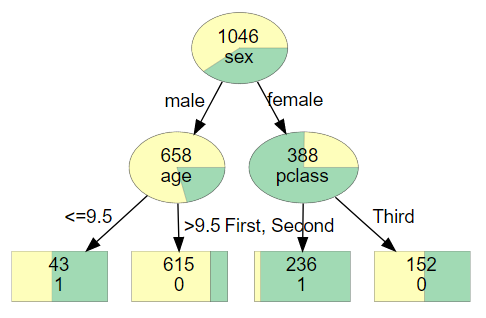
众所周知,scikit-learn作为Python中进行机器学习最常用最重要的一个库,它的CART可视化真的很糟糕(隔壁的R比它不知道高到哪里去了)。举个栗子,使用scikit-learn加上graphviz对泰坦尼克号存活数据进行可视化,你只能得到类似以下这个玩意,这对非数据科学领域的人非常极其的不友好。
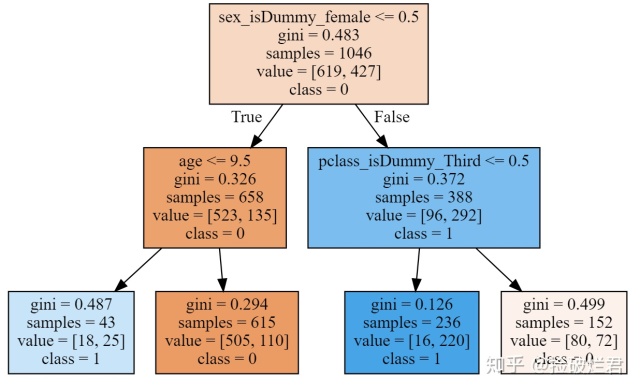
但是如果你用了如下的代码,那么你将得到这样一个一目了然的决策树!
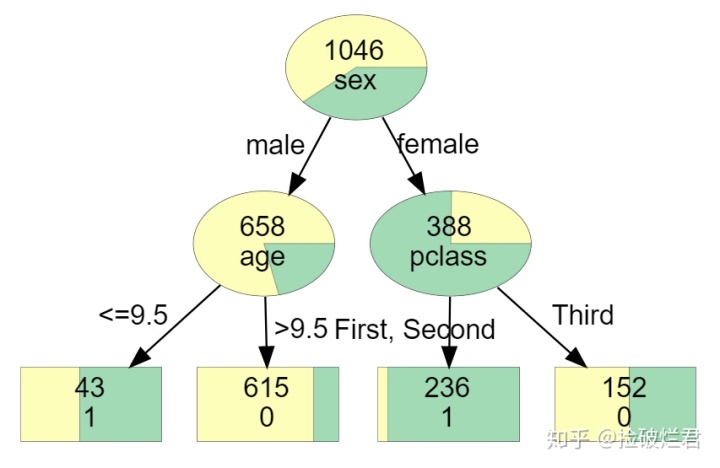
那么这么神奇的图是怎么得到的呢?废话不多说,小二上酸菜!
一. 决策树绘制的规则
决策树又分为分类树和回归树,前者用于预测分类后者用于预测数值。在原有的复杂且冗长的树图上我们将做如下改进。
- 分类树
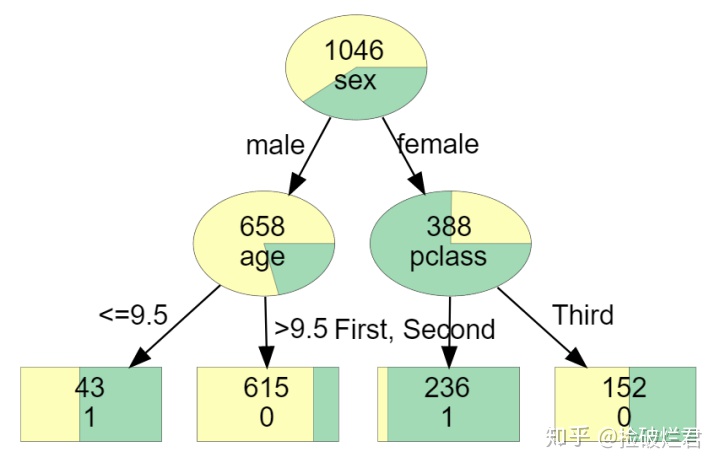
非叶节点上应有的信息:
- 是椭圆形
- 节点样本总数
- 用于判断的变量名称
- 各类组成结构饼状图
叶节点上应有信息:
- 是长方形
- 节点样本总数
- 类的名称
- 各类组成结构的柱状图
箭头上应有的信息:
- 如果判断变量为数值数据(Numerical Data),比如 age<= n:
- 左箭头上:<= n
- 右箭头上:> n
- 如果判断变量为分类数据(Categorical Data),
- 如果类别总数<= 5(比如 sex_isDummy_female <= 0.5):
- 左箭头上:male
- 右箭头上:female
- 如果类别总数量>5:
- 左箭头上:not female
- 右箭头上:female
- 如果类别总数<= 5(比如 sex_isDummy_female <= 0.5):
- 回归树
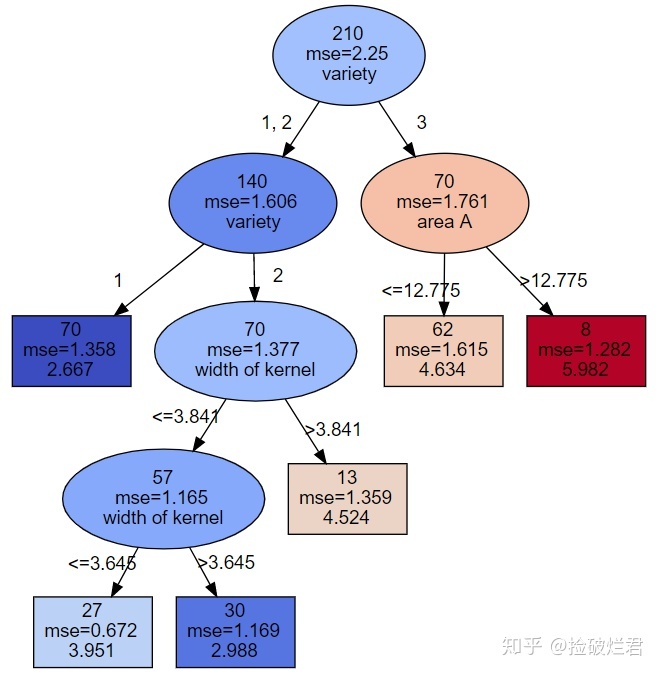
非叶节点上应有的信息:
- 是椭圆形
- 节点样本总数
- 误差值(Mean Square Error 或者 Mean Absolute Error)
- 用于判断的变量名称
- 数值颜色:颜色越冷(蓝)数值越小,颜色越热(红)数值越大
叶节点上应有信息:
- 是长方形
- 节点样品总数
- 预测的数值
- 数字颜色:颜色越冷(蓝)数值越小,颜色越热(红)数值越大
箭头上应有的信息(与分类树一样):
- 如果判断变量为数值数据(Numerical Data),比如 age<= n:
- 左箭头上:<= n
- 右箭头上:> n
- 如果判断变量为分类数据(Categorical Data),
- 如果类别总数<= 5(比如 sex_isDummy_female <= 0.5):
- 左箭头上:male
- 右箭头上:female
- 如果类别总数量>5:
- 左箭头上:not female
- 右箭头上:female
- 如果类别总数<= 5(比如 sex_isDummy_female <= 0.5):
二. 决策树可视化环境搭建
第一步上graphviz官方网站:http://www.graphviz.org/ 下载并安装graphviz
第二步给python安装graphviz库:pip install graphviz
第三步设置环境变量:
os.environ["PATH"] += os.pathsep + 'C:/Program Files (x86)/Graphviz2.38/bin/'
第四步:导入所有所需库
import 三. 先得到丑的那颗丑树
首先,我们先创建一个得到输入决策树所需所有参数的方程
输入:
- target: 所要预测目标变量的名字,是个字符串
- df: 表格
输出:
- yvec: 所要预测目标变量的序列
- xmat: 经过 dummy encoding 过后的表格
- vnames: 除去目标变量所有变量的名字
def get_yvec_xmat_vnames(target, df):
yvec = df[target]
# 将拥有n个不同数值的变量转换为n个0/1的变量,变量名字中有"_isDummy_"作为标注
xmat = pd.get_dummies(df.loc[:, df.columns != target], prefix_sep = "_isDummy_")
vnames = xmat.columns
return yvec, xmat, vnames导入数据,查看数据类型
(需要数据的在这里 链接: https://pan.baidu.com/s/1xPs4p2G8qIPIzqm2sP61Kg 提取码: f9nc)
df = pd.read_csv('Titanic.csv', header=0)
df.dtypes
转换数据到应有的类型,这里survived值虽然为0或1,但不是数字类型
df.survived = df.survived.astype(str)构建决策树模型
yvec, xmat, vnames = get_yvec_xmat_vnames("survived",df)
dt = DecisionTreeClassifier(max_depth=2, random_state=1234)
dt.fit(xmat, yvec)
使用graphviz绘制决策树
dot_data = tree.export_graphviz(dt,
feature_names = vnames,
filled=True)
graph = graphviz.Source(dot_data)
graph 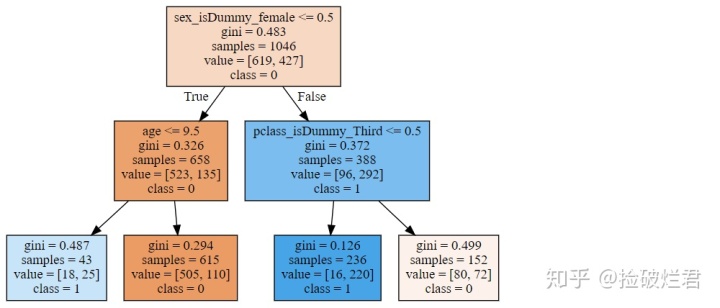
四. 再得到那颗优化过的树
首先我们需要一个储存所有名称及分类的字典
def get_categorical_dict(df):
# store all the values of categorical value
df_categorical = df.select_dtypes(include=['object', 'bool', 'category'])
categorical_dict = {}
for i in df_categorical.columns:
# store in descending order
categorical_dict[i]= sorted(list(set(df[i].astype('str'))))
return categorical_dict拿泰坦尼克号数据举例,我们得到:
get_categorical_dict(df)
然后我们构建一个新的绘制决策树的方程(不想看懂代码的直接复制粘贴就好)
def tree_to_dot(tree, target, df):
""" 把树变成dot data,用于输入graphviz然后绘制
参数
tree: DecisionTree的输出
target: 目标变量名字
df: 表单
输出
graphvic_str: dot data
"""
# get yvec, vnames and categorical_dict of the df
yvec, xmat, vnames = get_yvec_xmat_vnames(target, df)
categorical_dict = get_categorical_dict(df)
if is_classifier(tree):
# 如果是分类树
# classes should be in descending order
class_names = sorted(list(set(yvec)))
return classification_tree_to_dot(tree, vnames, class_names, categorical_dict)
else:
return regression_tree_to_dot(tree, vnames, categorical_dict)
def classification_tree_to_dot(tree, feature_names, class_names, categorical_dict):
""" 把分类树转化成dot data
参数
tree: DecisionTreeClassifier的输出
feature_names: vnames, 除去目标变量所有变量的名字
class_names: 目标变量所有的分类
categorical_dict: 储存所有名称及分类的字典
输出
graphvic_str: the dot data
"""
tree_ = tree.tree_
# store colors that distinguish discrete chunks of data
if len(class_names) <= 10:
# get the colorblind friendly colors
color_palette = adjust_colors(None)['classes'][len(class_names)]
else:
color_palette = sns.color_palette("coolwarm",len(class_names)).as_hex()
feature_name = [
feature_names[i] if i != _tree.TREE_UNDEFINED else "undefined!"
for i in tree_.feature
]
# initialize the dot data string
graphvic_str = 'digraph Tree {node [shape=oval, penwidth=0.1, width=1, fontname=helvetica] ; edge [fontname=helvetica] ;'
#print(graphvic_str)
def recurse(node, depth, categorical_dict):
# store the categorical_dict information of each side
categorical_dict_L = categorical_dict.copy()
categorical_dict_R = categorical_dict.copy()
# non local statement of graphvic_str
nonlocal graphvic_str
# variable is not dummy by default
is_dummy = False
# get the threshold
threshold = tree_.threshold[node]
# get the feature name
name = feature_name[node]
# judge whether a feature is dummy or not by the indicator "_isDummy_"
if "_isDummy_" in str(name) and name.split('_isDummy_')[0] in list(categorical_dict.keys()):
is_dummy = True
# if the feature is dummy, the threshold is the value following name
name, threshold = name.split('_isDummy_')[0], name.split('_isDummy_')[1]
# get the data distribution of current node
value = tree_.value[node][0]
# get the total amount
n_samples = tree_.n_node_samples[node]
# calculate the weight
weights = [i/sum(value) for i in value]
# get the largest class
class_name = class_names[np.argmax(value)]
# pair the color and weight
fillcolor_str = ""
for i, j in enumerate(color_palette):
fillcolor_str += j + ";" + str(weights[i]) + ":"
fillcolor_str = '"' + fillcolor_str[:-1] + '"'
if tree_.feature[node] != _tree.TREE_UNDEFINED:
# if the node is not a leaf
graphvic_str += ('{} [style=wedged, label=<{}<br/>{}>, fillcolor ='+fillcolor_str+'] ;').format(node,n_samples,name)
#print(('{} [style=wedged, label=<{}<br/>{}>, fillcolor ='+fillcolor_str+'] ;').format(node,n_samples,name))
if is_dummy:
# if the feature is dummy and if its total categories > 5
categorical_dict_L[name] = [str(i) for i in categorical_dict_L[name] if i != threshold]
categorical_dict_R[name] = [str(threshold)]
if len(categorical_dict[name])>5:
# only show one category on edge
threshold_left = "not " + threshold
threshold_right = threshold
else:
# if total categories <= 5, list all the categories on edge
threshold_left = ", ".join( categorical_dict_L[name])
threshold_right = threshold
else:
# if the feature is not dummy, then it is numerical
threshold_left = "<="+ str(round(threshold,3))
threshold_right = ">"+ str(round(threshold,3))
graphvic_str += ('{} -> {} [labeldistance=2.5, labelangle=45, headlabel="{}"] ;').format(node,tree_.children_left[node],threshold_left)
graphvic_str += ('{} -> {} [labeldistance=2.5, labelangle=-45, headlabel="{}"] ;').format(node,tree_.children_right[node],threshold_right)
#print(('{} -> {} [labeldistance=2.5, labelangle=45, headlabel="{}"] ;').format(node,tree_.children_left[node],threshold_left))
#print(('{} -> {} [labeldistance=2.5, labelangle=-45, headlabel="{}"] ;').format(node,tree_.children_right[node],threshold_right))
recurse(tree_.children_left[node], depth + 1,categorical_dict_L)
recurse(tree_.children_right[node], depth + 1,categorical_dict_R)
else:
# the node is a leaf
graphvic_str += ('{} [shape=box, style=striped, label=<{}<br/>{}>, fillcolor ='+fillcolor_str+'] ;').format(node,n_samples,class_name)
#print(('{} [shape=box, style=striped, label=<{}<br/>{}>, fillcolor ='+fillcolor_str+'] ;').format(node,n_samples,class_name))
recurse(0, 1,categorical_dict)
return graphvic_str + "}"
def regression_tree_to_dot(tree, feature_names, categorical_dict):
""" 把回归树转换成dot data
参数
tree: DecisionTreeClassifier的输出
feature_names: vnames, 除去目标变量所有变量的名字
categorical_dict: 储存所有名称及分类的字典
输出
graphvic_str: the dot data
"""
# get the criterion of regression tree: mse or mae
criterion = tree.get_params()['criterion']
tree_ = tree.tree_
value_list = tree_.value[:,0][:,0]
# Normalize data to produce heatmap colors
cmap = cm.get_cmap('coolwarm')
norm = Normalize(vmin=min(value_list), vmax=max(value_list))
rgb_values = (cmap(norm(value_list))*255).astype(int)
hex_values = ['#%02x%02x%02x' % (i[0], i[1], i[2]) for i in rgb_values]
feature_name = [
feature_names[i] if i != _tree.TREE_UNDEFINED else "undefined!"
for i in tree_.feature
]
# initialize the dot data string
graphvic_str = 'digraph Tree {node [shape=oval, width=1, color="black", fontname=helvetica] ;edge [fontname=helvetica] ;'
#print(graphvic_str)
def recurse(node, depth, categorical_dict):
# store the categorical_dict information of each side
categorical_dict_L = categorical_dict.copy()
categorical_dict_R = categorical_dict.copy()
# non local statement of graphvic_str
nonlocal graphvic_str
# variable is not dummy by default
is_dummy = False
# get the threshold
threshold = tree_.threshold[node]
# get the feature name
name = feature_name[node]
# judge whether a feature is dummy or not by the indicator "_isDummy_"
if "_isDummy_" in str(name) and name.split('_isDummy_')[0] in list(categorical_dict.keys()):
is_dummy = True
# if the feature is dummy, the threshold is the value following name
name, threshold = name.split('_isDummy_')[0], name.split('_isDummy_')[1]
# get the regression value
value = round(tree_.value[node][0][0],3)
# get the impurity
impurity = criterion+ "=" + str(round(tree_.impurity[node],3))
# get the total amount
n_samples = tree_.n_node_samples[node]
# pair the color with node
fillcolor_str = '"'+hex_values[node]+'"'
if tree_.feature[node] != _tree.TREE_UNDEFINED:
# if the node is not a leaf
graphvic_str += ('{} [style="filled", label=<{}<br/>{}<br/>{}>, fillcolor ='+fillcolor_str+'] ;').format(node,n_samples,impurity,name)
#print(('{} [style="filled", label=<{}<br/>{}<br/>{}>, fillcolor ='+fillcolor_str+'] ;').format(node,n_samples,impurity,name))
if is_dummy:
# if the feature is dummy and if its total categories > 5
categorical_dict_L[name] = [str(i) for i in categorical_dict_L[name] if i != threshold]
categorical_dict_R[name] = [str(threshold)]
if len(categorical_dict[name])>5:
# only show one category on edge
threshold_left = "not " + threshold
threshold_right = threshold
else:
# if total categories <= 5, list all the categories on edge
threshold_left = ", ".join(categorical_dict_L[name])
threshold_right = threshold
else:
# if the feature is not dummy, then it is numerical
threshold_left = "<="+ str(round(threshold,3))
threshold_right = ">"+ str(round(threshold,3))
graphvic_str += ('{} -> {} [labeldistance=2.5, labelangle=45, headlabel="{}"] ;').format(node,tree_.children_left[node],threshold_left)
graphvic_str += ('{} -> {} [labeldistance=2.5, labelangle=-45, headlabel="{}"] ;').format(node,tree_.children_right[node],threshold_right)
#print(('{} -> {} [labeldistance=2.5, labelangle=45, headlabel="{}"] ;').format(node,tree_.children_left[node],threshold_left))
#print(('{} -> {} [labeldistance=2.5, labelangle=-45, headlabel="{}"] ;').format(node,tree_.children_right[node],threshold_right))
recurse(tree_.children_left[node], depth + 1,categorical_dict_L)
recurse(tree_.children_right[node], depth + 1,categorical_dict_R)
else:
# the node is a leaf
graphvic_str += ('{} [shape=box, style=filled, label=<{}<br/>{}<br/>{}>, fillcolor ='+fillcolor_str+'] ;').format(node,n_samples,impurity,value)
#print(('{} [shape=box, style=filled, label=<{}<br/>{}<br/>{}>, fillcolor ='+fillcolor_str+'] ;').format(node,n_samples,impurity,value))
recurse(0, 1,categorical_dict)
return graphvic_str + "}"想要知道方程和 dot data 如何工作的可以将方程中的 print 行全部解除注释,然后逐行查看。至于里面的英文注释待我慢慢换成中文。。。
接下来运行 tree_to_dot 然后把生成的 dot data 放入graphviz中
dot_data = tree_to_dot(dt, "survived",df)
graph = graphviz.Source(dot_data)
graph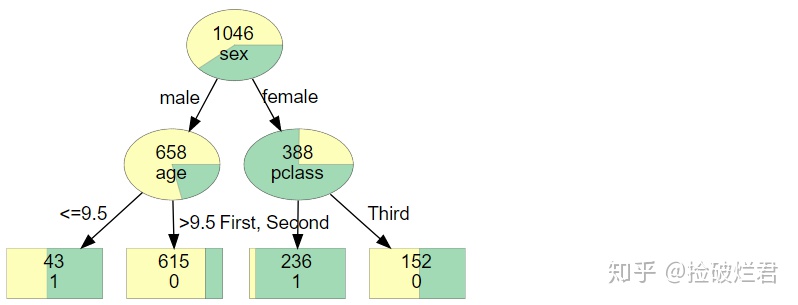
好看的树就诞生啦!
五. 一些栗子
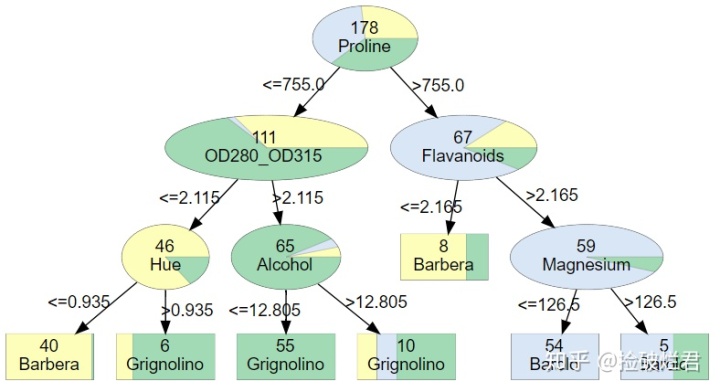
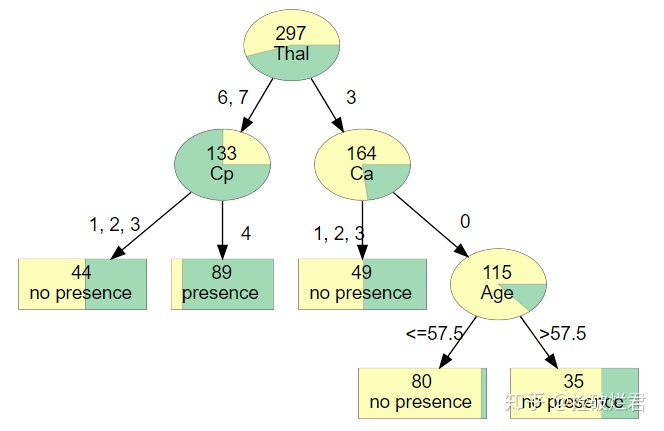
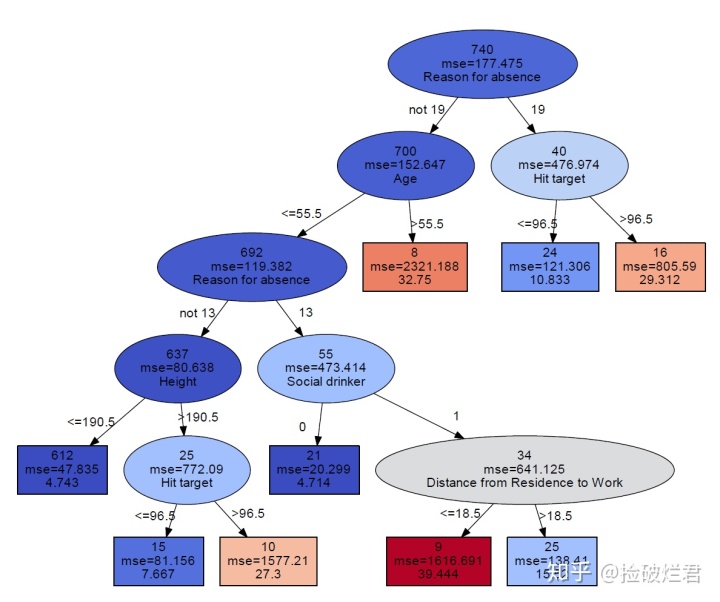
不要光收藏不点赞哦
最后
以上就是苹果灰狼最近收集整理的关于graphviz python_Python | 基于scikit-learn决策树可视化优化的全部内容,更多相关graphviz内容请搜索靠谱客的其他文章。







![[开发环境]graphviz环境安装](https://file2.kaopuke.com:8081/files_image/reation/bcimg4.png)
发表评论 取消回复